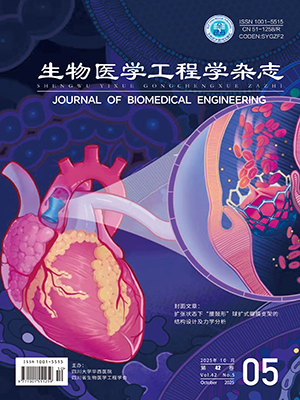| 1. |
Gerson A D, Parra L C, Sajda P. Cortically coupled computer vision for rapid image search. IEEE Trans Neural Syst Rehabil Eng, 2006, 14(2): 174-179.
|
| 2. |
Poolman P, Frank R M, Luu P, et al. A single-trial analytic framework for EEG analysis and its application to target detection and classification. Neuroimage, 2008, 42(2): 787-798.
|
| 3. |
Lees S, Dayan N, Cecotti H, et al. A review of rapid serial visual presentation-based brain-computer interfaces. J Neural Eng, 2018, 15: 021001.
|
| 4. |
Chen J, Mao Z, Zheng R, et al. Feature selection of deep learning models for EEG-based RSVP target detection. IEICE Transactions on Information and Systems, 2019, 102-D(4): 836-844.
|
| 5. |
Potter M C, Fox L F. Detecting and remembering simultaneous pictures in a rapid serial visual presentation. J Exp Psychol Hum Percept Perform, 2009, 35(1): 28-38.
|
| 6. |
Ichikawa M, Miyoshi M. Perceived duration depends upon target detection in rapid serial visual presentation sequence. i-Perception, 2020, 11(6): 1-18.
|
| 7. |
Marx S, Hansen-Goos O, Thrun M, et al. Rapid serial processing of natural scenes: color modulates detection but neither recognition nor the attentional blink. J Vis, 2014, 14(14): 4.
|
| 8. |
赵仑. ERPs实验教程. 南京: 东南大学出版社, 2010: 70-73.
|
| 9. |
Mantini D, Corbetta M, Perrucci M G, et al. Large-scale brain networks account for sustained and transient activity during target detection. Neuroimage, 2009, 44(1): 265-274.
|
| 10. |
Kopp B, Steinke A, Visalli A. Cognitive flexibility and N2/P3 event-related brain potentials. Sci Rep UK, 2020, 10(1): 9859.
|
| 11. |
Cecotti H, Eckstein M P, Giesbrecht B. Single-trial classification of event-related potentials in rapid serial visual presentation tasks using supervised spatial filtering. IEEE Trans Neural Netw Learn Syst, 2014, 25(11): 2030-2042.
|
| 12. |
Rizi F S, Abootalebi V, Sadeghi M T. Spatial and spatio-temporal filtering based on common spatial patterns and Max-SNR for detection of P300 component. Biocybern Biomed Eng, 2017, 37(3): 365-372.
|
| 13. |
Zhang Y, Zhou G, Zhao Q, et al. Spatial-temporal discriminant analysis for ERP-based brain-computer interface. IEEE Trans Neural Syst Rehabil Eng, 2013, 21(2): 233-243.
|
| 14. |
Cecotti H. Single-trial detection with magnetoencephalography during a dual-rapid serial visual presentation task. IEEE Trans Biomed Eng, 2016, 63(1): 220-227.
|
| 15. |
Parra L C, Christoforou C, Gerson A D, et al. Spatiotemporal linear decoding of brain state. IEEE Signal Proc Mag, 2008, 25(1): 107-115.
|
| 16. |
Marathe A R, Ries A J, Mcdowell K. Sliding HDCA: single-trial EEG classification to overcome and quantify temporal variability. IEEE Trans Neural Syst Rehabil Eng, 2014, 22(2): 201-211.
|
| 17. |
Fuhrmann A G, Manor R, Spanier A B, et al. Spatiotemporal representations of rapid visual target detection: a single-trial EEG classification algorithm. IEEE Trans Biomed Eng, 2014, 61(8): 2290-2303.
|
| 18. |
Blankertz B, Tomioka R, Lemm S, et al. Optimizing spatial filters for robust EEG single-trial analysis. IEEE Signal Processing Magazine, 2007, 25(1): 41-56.
|
| 19. |
Ghani U, Signal N, Niazi I K, et al. ERP based measures of cognitive workload: a review. Neurosci Biobehav Rev, 2020, 118: 18-26.
|
| 20. |
Acqualagna L, Blankertz B. Gaze-independent BCI-spelling using rapid serial visual presentation (RSVP). Clin Neurophysiol, 2013, 124(5): 901-908.
|
| 21. |
Shih S. The attention cascade model and attentional blink. Cogn Psychol, 2008, 56(3): 210-236.
|
| 22. |
Petrucci M, Pecchinenda A. Sparing and impairing: emotion modulation of the attentional blink and the spread of sparing in a 3-target RSVP task. Atten Percept Psycho, 2018, 80(2): 439-452.
|
| 23. |
赖虹宇, 冯静雯, 王毅, 等. 抑郁症和精神分裂症患者静息态脑电信号的分类研究. 生物医学工程学杂志, 2019, 36(6): 916-923.
|
| 24. |
Ramoser H, Müller-Gerking J, Pfurtscheller G. Optimal spatial filtering of single trial EEG during imagined hand movement. IEEE Trans Rehabil Eng, 2000, 8(4): 441-446.
|
| 25. |
Müller-Gerking J, Pfurtscheller G, Flyvbjerg H, et al. Designing optimal spatial filters for single-trial EEG classification in a movement task. Clinical Neurophysiology, 1999, 110(5): 787-798.
|
| 26. |
Lin Z, Zhang C, Zeng Y, et al. A novel P300 BCI speller based on the triple RSVP paradigm. Sci Rep UK, 2018, 8: 3350.
|
| 27. |
Deng Xinyang, Liu Qi, Deng Yong, et al. An improved method to construct basic probability assignment based on the confusion matrix for classification problem. Inform Sciences, 2016, 340-341: 250-261.
|
| 28. |
李亚兵, 谢松云, 于圳宁, 等. 基于动态偏定向相干的运动想象因效性网络分析. 生物医学工程学杂志, 2020, 37(1): 38-44.
|
| 29. |
Wang X, Zeng Y, Lin Z, et al. Combining multiple ERP components for detecting targets in remote-sensing images. Intelligent Human-Machine Systems and Cybernetics (IHMSC), 2017, 2017: 167-170.
|
| 30. |
Liu Shuang, Wang Wei, Sheng Yue, et al. Improving the cross-subject performance of the ERP-based brain-computer interface using rapid serial visual presentation and correlation analysis rank. Front Hum Neurosci, 2020, 14: 296.
|
| 31. |
Delorme A, Makeig S. EEGLAB: an open source toolbox for analysis of single-trial EEG dynamics including independent component analysis. J Neurosci Methods, 2004, 134(1): 9-21.
|




